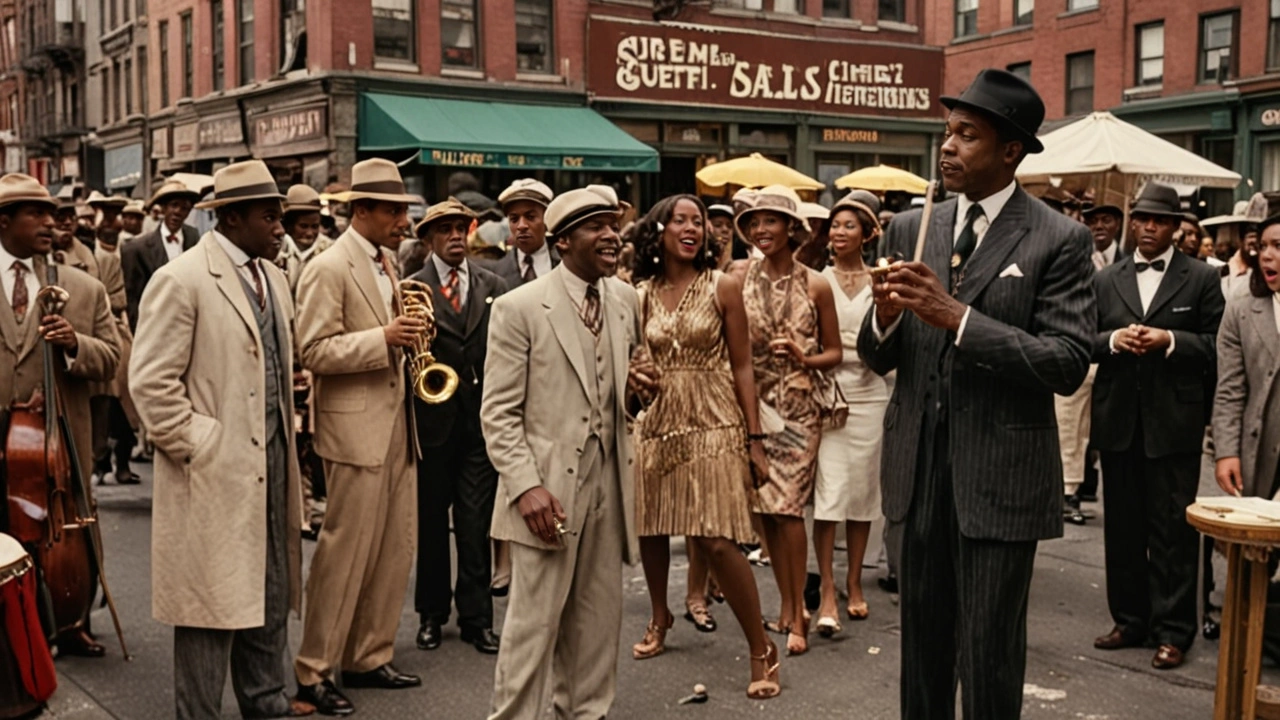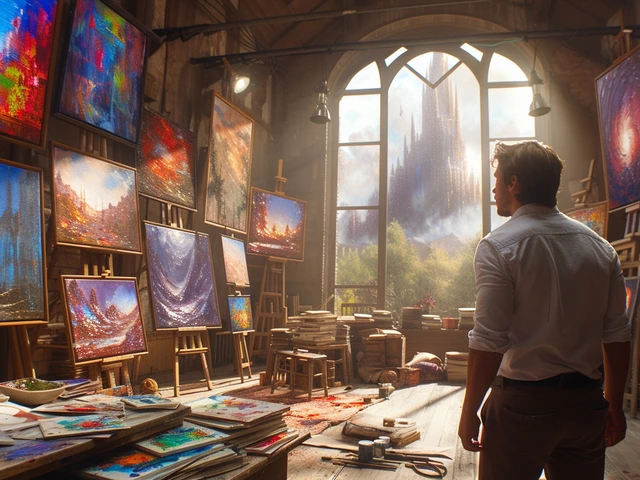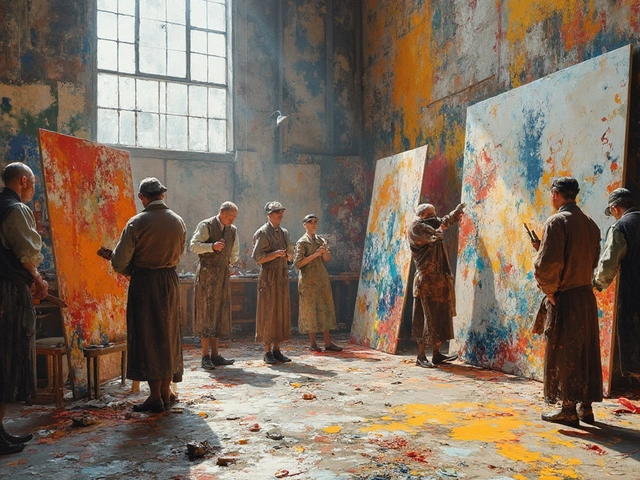The Harlem Renaissance was a brilliant beacon of African-American culture during the 1920s and 1930s, radiating out of Harlem, New York City. This period was marked by an explosion in the arts—literature, music, theater, and visual arts—that sought to redefine and celebrate African-American identity and culture.
Among the era's key figures were writers like Langston Hughes and Zora Neale Hurston, who used their pens to paint vivid, often provocative, depictions of black life. Musicians such as Duke Ellington and Louis Armstrong took the world by storm, their melodies weaving the complexity of African-American experiences into jazz and blues. And artists like Aaron Douglas encapsulated the spirit of the age through striking visuals that drew from African traditions.
The impact of this cultural renaissance extends far beyond its immediate aftermath. Modern culture still echoes with Harlem Renaissance's call for equality and innovation, visible in contemporary literature, music genres like hip-hop, visual storytelling, and ongoing social movements. By tracing these influences, we can better appreciate this critical period's enduring legacy.
- Introduction to the Harlem Renaissance
- Key Figures and Contributions
- Artistic and Literary Influences
- Music and Performance Legacy
- Impact on Civil Rights and Society
- Contemporary Reflections
Introduction to the Harlem Renaissance
The Harlem Renaissance, which flourished in the 1920s and 1930s, was a pivotal moment in American culture. Centered in the Harlem neighborhood of New York City, it was both a cultural awakening and a social revolution. The movement saw African-Americans embracing their identity and heritage, and using creative arts to express their experiences and aspirations. It was during this time that the term 'New Negro' gained popularity, representing a shift towards self-respect and racial pride.
Harlem, originally developed as an affluent white suburb, transformed into a vibrant hub of black culture as African-Americans migrated from the South and Caribbean. This community brought with it a rich tapestry of traditions, folk music, and resilience, which were crucial in shaping the Renaissance. It wasn’t just the arts that were booming; Harlem Renaissance also powered discussions on civil rights, influencing future movements significantly.
One cannot discuss this era without mentioning key figures such as Langston Hughes, whose poetic reflections on black life became the voice of the Renaissance.
“I swear to the Lord, I still can't see, why Democracy means, everybody but me.” - Langston HughesZora Neale Hurston, another literary giant, offered profound insight into African-American folklore and communities through her works. The music scene was just as revolutionary, with jazz musicians like Duke Ellington and Bessie Smith breaking new ground and captivating audiences worldwide.
Beyond literature and music, visual art played a significant role in the Harlem Renaissance. Artists like Aaron Douglas and Augusta Savage used their talents to create powerful pieces that resonated with their heritage and struggles. Their works often depicted African motifs and human figures, bridging the past with contemporary issues. This cross-disciplinary explosion of creativity redefined how African-Americans viewed themselves and were perceived by others.
The Harlem Renaissance was much more than an artistic movement; it was a reclaiming of narrative and space. By showcasing the depth and richness of black culture, it dismantled many prejudiced stereotypes that had long persisted. The reverberations of this era are felt across modern culture, from the rhythms of hip-hop to the nuanced storytelling in contemporary black literature and cinema. Reflecting on this period sheds light on how it has shaped, and continues to shape, the fight for equality and the celebration of diversity.
Key Figures and Contributions
The Harlem Renaissance was a playground of brilliance, where intellects and artists of African-American descent rose to prominence. At the forefront was Langston Hughes, a seminal poet and social activist. Known for his insightful, lyrical poetry, Hughes captured the essence of Black life in America. His works like 'The Weary Blues' and 'Mother to Son' resonate to this day, exploring themes of struggle and hope. His famous line,
‘Life for me ain't been no crystal stair,’serves as a powerful metaphor for the Black experience.
Another towering figure was Zora Neale Hurston, whose novel 'Their Eyes Were Watching God' remains a staple in American literature. Hurston's ability to weave folklore with deep emotional and societal observations made her work both unique and poignant. She wasn't just a storyteller; she was an anthropologist who deeply investigated African-American culture and the human condition.
The realm of music saw legends like Duke Ellington and Louis Armstrong. Ellington, with his orchestra, brought jazz into the mainstream arena. His compositions like 'Mood Indigo' and 'It Don't Mean a Thing' not only entertained but also innovated, blending various musical elements to create something truly new. Louis Armstrong, with his horn and distinct gravelly voice, pushed the boundaries of jazz. His improvisations and charismatic performances turned him into a global icon.
In visual arts, Aaron Douglas stood out with his work encapsulating the essence of the Harlem Renaissance. Using a style influenced by African art, he created murals and illustrations that spoke volumes about the Black experience. His works adorned public spaces and publications, communicating a powerful narrative about African-American identity.
It's essential to acknowledge the impact of lesser-known yet significant contributors like Jessie Redmon Fauset, an editor, poet, and novelist who nurtured many young writers. Her editorial work in 'The Crisis,' the official magazine of the NAACP, provided a platform for burgeoning talent. Similarly, Alain Locke, often dubbed as the 'Dean' of the Harlem Renaissance, advocated for a new African-American cultural identity. His anthology, 'The New Negro,' collected works from many Renaissance writers and became a cornerstone of the movement. Clarkson highlighted the unique qualities of artists like Hughes and Hurston and encouraged self-expression and innovation.
The Harlem Renaissance was not just about individual contributions but also about the collective energy and shared mission. As artists gathered in Harlem's vibrant salons and jazz clubs, they exchanged ideas and inspired one another. This synergy fueled a cultural and intellectual growth that transcended boundaries and shaped the course of American history, leaving an impact that still reverberates today.
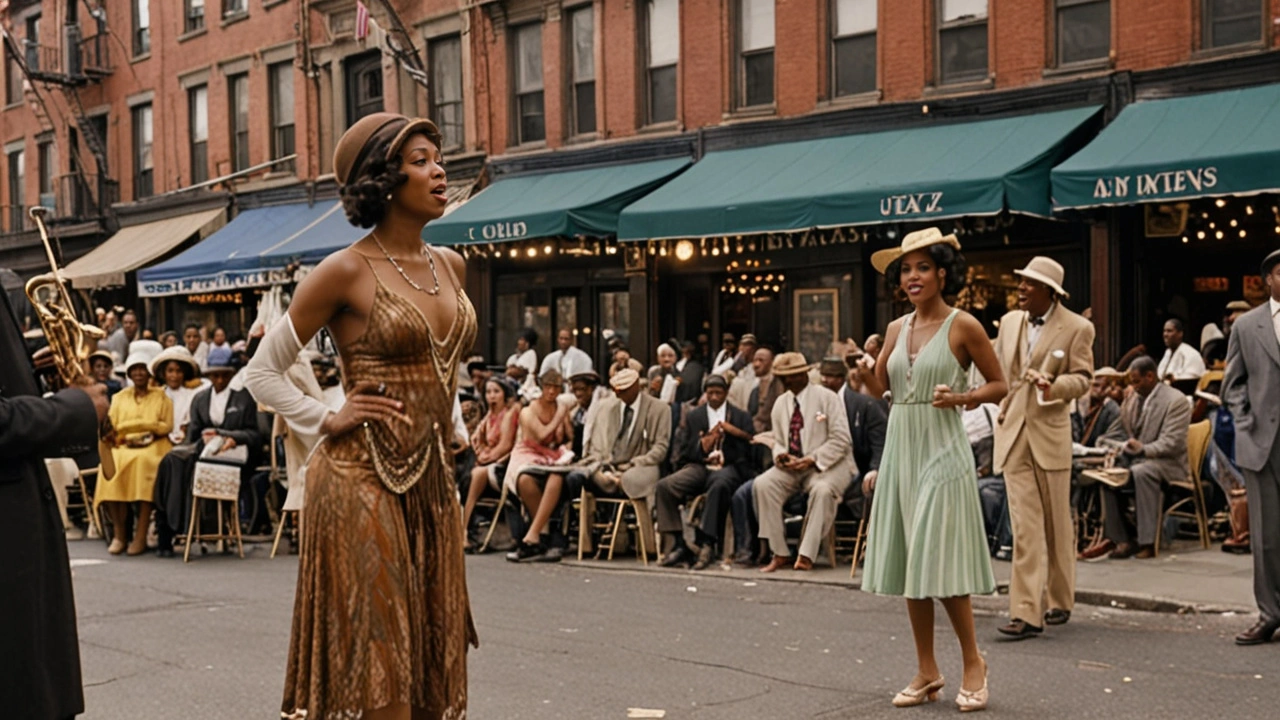
Artistic and Literary Influences
The artistic and literary arenas of the Harlem Renaissance presented a groundbreaking explosion of creativity, which significantly contributed to shaping modern culture. This period saw an unprecedented outpouring of African-American expressive arts that sought to redefine what it meant to be black in America.
One of the most influential figures was Langston Hughes, whose poetry captured the spirit of the African-American experience with vivid imagery and emotional depth. His works, like “The Weary Blues,” reflected the cadence and rhythm of jazz, a hallmark of the era. Hughes once said, “I’ll stand high on the sky ... to the tune o’ my guitar.” This quote not only highlights his love for music but also the indomitable spirit of the people he wrote about.
The literary contributions of the Harlem Renaissance were not limited to poetry. Zora Neale Hurston’s prose brought the richness of African-American folklore and the strength of black women to the forefront. Her acclaimed novel,
Music and Performance Legacy
The Harlem Renaissance was a transformative moment for music, particularly jazz and blues, which were integral to the era’s cultural core. Harlem became the epicenter of vibrant musical innovation, spearheaded by luminaries like Duke Ellington, Louis Armstrong, and Bessie Smith. The soundscapes they created didn’t just entertain; they also told powerful stories of joy, struggle, and the African-American experience.
Duke Ellington, a giant of jazz, crafted compositions that went beyond dance music. His work was deeply sophisticated, often reflecting the complex, layered history of African-American life. With his orchestra at The Cotton Club, Ellington introduced a wider audience to the rich textures of jazz. Louis Armstrong, with his groundbreaking trumpet solos and charismatic vocals, revolutionized the genre by emphasizing improvisation and technical skill. Bessie Smith, known as the “Empress of the Blues,” gave voice to the pains and triumphs of women, influencing future generations of female singers.
Live performances during the Harlem Renaissance were more than just shows; they were profound communal experiences that reinforced cultural pride and identity. The Savoy Ballroom and The Cotton Club were iconic venues where black and white audiences, though often segregated, shared in the magic of the music. These spaces were breeding grounds for new styles and techniques, where the sophisticated swing of Ellington met the raw, emotional outpourings of blues artists.
The influence of Harlem Renaissance music still resonates today. The improvisational genius of jazz paved the way for modern genres like bebop and hip-hop. The personal narrative style of blues can be heard in contemporary R&B and soul music. Innovators from the Renaissance not only shaped the music of their time but also laid the groundwork for future artists to push creative boundaries.
"Jazz is the only music in which the same note can be played night after night but differently each time." - Ornette ColemanClubs and theaters like Apollo Theater and The Savoy were not only venues but cultural landmarks that showcased the talents and fostered careers of numerous black performers. These stages provided platforms that were otherwise denied due to segregation laws and social prejudices of the time.
Moreover, the Harlem Renaissance also saw the rise of performance poetry and spoken word, with figures like Langston Hughes using the rhythm of jazz in their written verses. This blending of music and literature created a unique cultural artifact that would inspire generations of poets and musicians.
In essence, the Harlem Renaissance’s music scene was a rich tapestry that wove together diverse strands of African-American heritage, resulting in a vibrant cultural explosion. Its legacy lives on, infiltrating modern soundscapes and inspiring artists to this day. Jazz, blues, and the ethos of artistic exploration that defined this era continue to be celebrated for their contributions to cultural expression and social change.
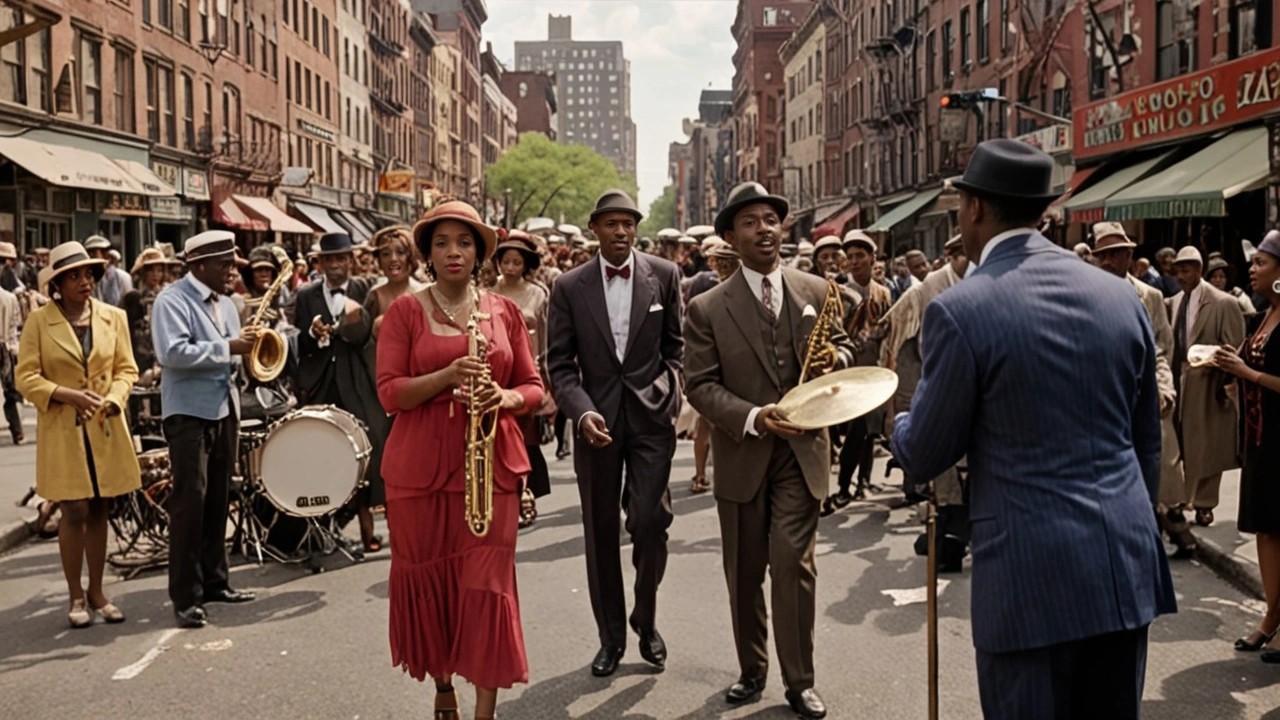
Impact on Civil Rights and Society
The Harlem Renaissance not only revolutionized art and literature but also enormously impacted the civil rights movement and society as a whole. During this period, African-American intellectuals, artists, and activists started to reshape public perceptions through their works, fighting against racial stereotypes and advocating for social justice. Figures like W.E.B. Du Bois played a crucial role in this transformation. His work 'The Souls of Black Folk' exposed the deep-seated racism and urged African-Americans to take pride in their heritage.
Langston Hughes, another towering figure, encouraged a sense of unity and resilience in the face of oppression. His poetry often resonated with the everyday struggles faced by African-Americans, transforming into a rallying cry for equality. The line from his famous poem, 'Let America Be America Again,' embodies this spirit: "O, let America be America again—The land that never has been yet—And yet must be—the land where every man is free."
Moreover, the Harlem Renaissance led to the formation of several organizations that actively campaigned for civil rights. The NAACP (National Association for the Advancement of Colored People) and the National Urban League gained momentum during this period. These institutions organized protests, published influential papers, and provided platforms for the voices of African-Americans that demanded equality and justice. Such grass-root movements inspired the larger Civil Rights Movement that peaked in the 1960s.
The cultural outputs of this era also left a lasting mark on society. Jazz and blues music, born from the Harlem Renaissance, broke color barriers and eventually became global phenomena. These genres carried implicit messages of resistance and liberation, influencing public opinion and fostering greater acceptance of African-American culture. Artists like Duke Ellington and Billie Holiday didn't just entertain; they challenged societal norms and opened doors for future generations of black performers.
Another significant impact is observed in education and scholarship. The Harlem Renaissance brought a wealth of literature and critical thinking into the mainstream academic discourse. Scholars began to seriously study African-American history and culture, which had been grossly neglected. This academic shift prompted educational reforms and played a foundational role in establishing African-American Studies programs in universities across the United States.
The Harlem Renaissance's influence extended into the political arena as well. Politicians of the time could no longer ignore the issues raised by African-American communities. The movement helped lay the groundwork for significant legislative changes in subsequent decades, such as the Civil Rights Act of 1964 and the Voting Rights Act of 1965. These milestones were achieved thanks to the unwavering spirit of those who lived during the Renaissance and their successors.
In essence, the Harlem Renaissance was not just an artistic movement; it was a catalyst for societal change. It challenged discrimination head-on and laid the intellectual foundation for the Civil Rights Movement. The lessons from this period are timeless, offering invaluable insights into the ongoing struggles for equality and justice in modern times.
Contemporary Reflections
The legacy of the Harlem Renaissance is undeniably omnipresent in today's cultural landscape. Its spirit of innovation and defiance against racial inequality continues to resonate. Nowhere is this more evident than in the world of literature. Contemporary African-American writers, such as Toni Morrison and Ta-Nehisi Coates, weave narratives that echo the themes of resilience and identity first explored during the Renaissance. Their works, celebrated both critically and commercially, are steeped in the same rich tradition of storytelling that Langston Hughes championed.
Music, too, carries the Harlem Renaissance's influence into the present. Hip-hop, with its roots deeply embedded in African-American culture, often channels the same social consciousness that jazz and blues did during the Renaissance. Artists like Kendrick Lamar and J. Cole not only push musical boundaries but also address enduring issues of racial inequality and cultural pride. Through their lyrics, they create a modern-day continuum of the Harlem Renaissance's artistic rebellion.
Visual arts have seen a revival of styles and themes from the Harlem Renaissance as well. The bold, dynamic works of artists like Kara Walker and Kehinde Wiley draw from the visual lexicon established by predecessors such as Aaron Douglas. These contemporary artists explore and challenge historical narratives, much in the same way that Renaissance artists did, demanding a reckoning with the past while celebrating black identity and experience.
Moreover, the Harlem Renaissance's impact can also be felt in the broader societal and political movements of today. The Black Lives Matter movement, for instance, mirrors the Renaissance's rallying cry for social justice and equality. It brings to the forefront the same demands for acknowledgment and respect that were championed nearly a century ago. This continuity highlights the Renaissance's role as a catalyst for ongoing activism and societal change.
Education and academia have also embraced the Harlem Renaissance as a critical field of study. Universities and cultural institutions now dedicate significant resources to exploring and teaching this influential period. Courses and exhibitions focused on Harlem Renaissance figures and their contributions help new generations appreciate the depth and breadth of this cultural revolution. This academic recognition ensures that the lessons and legacies of the Harlem Renaissance remain a vibrant part of our collective consciousness.
It's clear that the Harlem Renaissance's influence is not confined to history books. Its ripples are seen and felt in the very fabric of modern culture, from literature and music to activism and education. By understanding and appreciating this profound cultural movement, we gain valuable insights into the persistent quest for equality and artistic expression. The Renaissance's call to celebrate and elevate African-American identity continues to inspire and challenge us today, reminding us of the enduring power of art and culture as forces for change.

